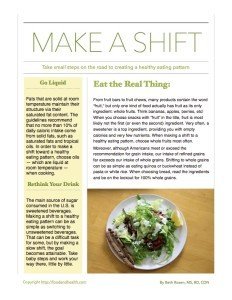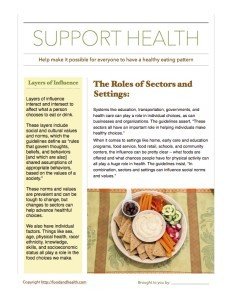Tips to Shift to a Healthy Eating Pattern
The newest edition of the Dietary Guidelines for Americans recommends a shift in our eating patterns, from what Americans typically eat to a diet that is nutrient-dense and mostly plant-based. Currently, 75% of Americans eat a diet that is low in fruits, vegetables and oils, while consuming an excess amount of solid fats, added sugars, and sodium. Our current typical American diet is contributing to the obesity epidemic, with two thirds of adults and one third of children falling into the overweight or obese categories for body mass index. This excess weight puts us at an increased risk for chronic disease.In order for a shift in the typical American diet to become a long-term, healthy habit, small changes in our diets should be made over time. Here are four tips to increase your nutrient-dense food intake and reduce the consumption of empty calorie foods in your food pattern:
- Eat the real thing. From fruit bars to fruit chews, many products contain the word “fruit,“ but only one kind of food actually has fruit as its only ingredient: whole fruits like bananas, apples, and berries! When you choose snacks with “fruit” in the title, fruit is most likely not the first (or even the second) ingredient. Very often, sugar, or another sweetener, is a top ingredient, providing you with empty calories and very few nutrients. When making a shift to a healthy eating pattern, choose whole fruits most often. They have natural sweetness, but also come with a nutrient-dense bonus of vitamins, minerals, and fiber.
- Go liquid. Fats that are solid at room temperature maintain their structure via their saturated fat content. The guidelines recommend that no more than 10% of daily caloric intake come from solid fats, such as saturated fats and tropical oils. In order to make a shift toward a healthy eating pattern, choose oils -- which are liquid at room temperature -- when cooking. Oil consumption can replace solid fat consumption when foods with naturally-occurring oils, such as those in fish, nuts and seeds, are eaten. Another strategy to reduce solid fats is to minimize the intake of products that contain them, such as commercially-produced baked goods and snack chips.
- Rethink your drink. The main source of sugar consumed in the U.S. comes in the form of sweetened beverages like soda, energy drinks, fruit drinks, and sweetened coffee and tea. Making a shift to a healthy eating pattern can be as simple as switching to unsweetened beverages like water, seltzer, and black coffee. That can be a difficult task for some, but by making a slow shift, the goal becomes attainable. Begin to mix your soda with seltzer at a 50:50 ratio, and, over time, change the ratio until you are able to drink the seltzer plain. The same technique can be used to reduce juice intake when it is mixed with water. You can also slowly reduce the amount of sugar you add to your hot beverages by using less each day, giving your taste buds the opportunity to adjust to your new healthy eating pattern.
- Go for whole. Making half of your grains whole is not a new recommendation from the guidelines, but we have yet to reach that goal in our current eating pattern. Americans meet or exceed the recommendation for grain intake, and yet our intake of refined grains far exceeds our intake of whole grains. Shifting to whole grains can be as simple as eating quinoa, barley, or buckwheat instead of pasta or white rice. When choosing bread, read the ingredients and be on the lookout for 100% whole grains such as wheat or rye. The word “whole” should appear before the name of the grain.
A healthy eating plan supports a healthy body weight and reduces the risk for chronic disease. Striving to make small changes over time will help you make a successful shift toward a lifetime of nutrient-dense food choices.By Beth Rosen, MS, RD, CDNNot a member? Join now to get access to all premium content and tools. Here's a brand-new PDF handout with this information! How will you use your copy? And for even more information about the 2015-2020 edition of the Dietary Guidelines for Americans, don't miss the member-exclusive post Creating a Framework for Healthy Eating Patterns. It has a fresh look at some new materials that our team developed for the latest edition of the Dietary Guidelines for Americans.
And for even more information about the 2015-2020 edition of the Dietary Guidelines for Americans, don't miss the member-exclusive post Creating a Framework for Healthy Eating Patterns. It has a fresh look at some new materials that our team developed for the latest edition of the Dietary Guidelines for Americans. There are great Dietary Guidelines resources in the Nutrition Education Store as well. Which ones will make your life easier?
There are great Dietary Guidelines resources in the Nutrition Education Store as well. Which ones will make your life easier?




